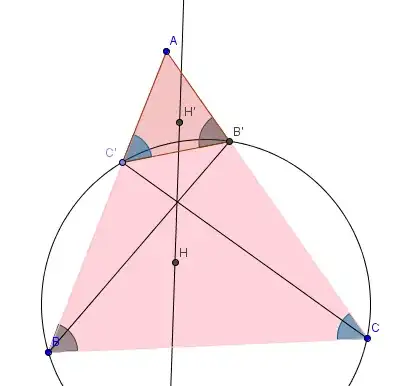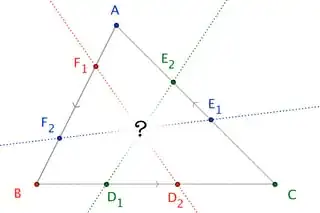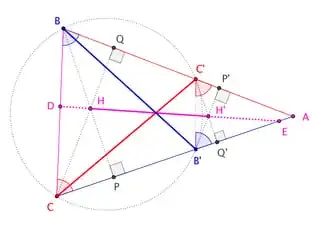Here is a complete proof along the lines of my comments to the OP. Most of it
is well-known stuff, but it probably doesn't hurt to build it from scratch.
First of all, the problem follows from the following claim:
Theorem 1. Let $A$, $B$, $C$ and $D$ be four points on a circle. Let
$X=AB\cap CD$ and $Y=BC\cap DA$. (I use the notation $\ell\cap m$ to denote
the point of intersection of two lines $\ell$ and $m$, even though it would be
more formally correct to say that $\ell\cap m$ is a one-element set consisting
of this point. I also pretend that everything is in general position when
needed, as usually done in this kind of geometry.) Then, the orthocenters of
the triangles $XBC$, $XDA$, $YAB$ and $YCD$ lie on one line, and the point
$AC\cap BD$ also lies on this line.
To recover the original problem from this theorem, we need to apply it to $C$,
$B^{\prime}$, $C^{\prime}$, $B$ and $A$ instead of $A$, $B$, $C$, $D$ and $X$.
Theorem 1 is not the pinnacle of generality. Indeed, there is a more
well-known fact which generalizes it:
Theorem 2. Let $A$, $B$, $C$ and $D$ be four points on the plane. Let
$X=AB\cap CD$ and $Y=BC\cap DA$. Then:
(a) The midpoints of the segments $AC$, $BD$ and $XY$ lie on one line.
(b) The circles with diameters $AC$, $BD$ and $XY$ are coaxal (i.e.,
their pairwise radical axes coincide).
(c) The orthocenters of the triangles $XBC$, $XDA$, $YAB$ and $YCD$
all lie on the radical axis of any two of the circles with diameters $AC$,
$BD$ and $XY$.
(d) If the points $A$, $B$, $C$ and $D$ lie on one circle, then the
point $AC\cap BD$ also lies on this radical axis.
It is clear that parts (c) and (d) of Theorem 2, when
combined, yield Theorem 1. It therefore only remains to prove Theorem 2.
Part of Theorem 2 (I am not sure which part) is called the Gauss-Bodenmiller
theorem. Also, the line constructed in Theorem 2 (a) is known as the
Gauss-Newton line of the complete quadrilateral formed by the lines $AB$,
$BC$, $CD$ and $DA$. The radical axis in Theorem 2 (c) is known as the
Miquel-Steiner line of this complete quadrilateral.
Notice that Theorem 2 (a) is a purely affine
statement (i.e., it involves only constructions invariant under affine
transformations, such as midpoints of segments and intersections of lines),
but we will prove it as a side effect of an argument that involves circles.
Proof of Theorem 2. We introduce the notation $\operatorname*{Thal}
\left( PQ\right) $ for the circle with diameter $PQ$, where $P$ and $Q$ are
any two points. We also define $\operatorname*{Rad}\left( k,k^{\prime
}\right) $ to be the radical axis of two circles $k$ and $k^{\prime}$.
Finally, we let $H_{PQR}$ denote the orthocenter of any triangle $PQR$.
We notice that the orthocenters $H_{XBC}$, $H_{XDA}$, $H_{YAB}$ and $H_{YCD}$
are pairwise distinct when $A$, $B$, $C$ and $D$ are in general position. This
allows us to WLOG assume that these four orthocenters are distinct; we will
use this assumption below.
Let us begin by proving that $H_{XBC}\in\operatorname*{Rad}\left(
\operatorname*{Thal}\left( AC\right) ,\operatorname*{Thal}\left( BD\right)
\right) $. Indeed, let $B^{\prime}$ be the foot of the altitude of triangle
$XBC$ emanating from $B$. Then, $H_{XBC}\in BB^{\prime}$, so that $BB^{\prime
}=BH_{XBC}$. Also, $BB^{\prime}\perp XC$ (since $B^{\prime}$ is the foot of
the altitude from $B$ to $XC$), and thus $\measuredangle BB^{\prime
}D=90^{\circ}$, so that $B^{\prime}\in\operatorname*{Thal}\left( BD\right)
$. Also, $BB^{\prime}\perp XC$ yields $\measuredangle BB^{\prime}C=90^{\circ}
$, so that $B^{\prime}\in\operatorname*{Thal}\left( BC\right) $. From
$B^{\prime}\in\operatorname*{Thal}\left( BC\right) $ and $B^{\prime}
\in\operatorname*{Thal}\left( BD\right) $, we see that the circles
$\operatorname*{Thal}\left( BC\right) $ and $\operatorname*{Thal}\left(
BD\right) $ have the point $B^{\prime}$ in common. Since they also have the
point $B$ in common, this shows that the circles $\operatorname*{Thal}\left(
BC\right) $ and $\operatorname*{Thal}\left( BD\right) $ intersect at the
two points $B$ and $B^{\prime}$ (here we WLOG assume that $B$ and $B^{\prime}$
are distinct, which is another consequence of general position). Thus, the
radical axis of these circles is $\operatorname*{Rad}\left(
\operatorname*{Thal}\left( BC\right) ,\operatorname*{Thal}\left( BD\right)
\right) =BB^{\prime}=BH_{XBC}$.
The same argument (but applied to $D$, $C$, $B$ and $A$ instead of $A$, $B$,
$C$ and $D$) shows that $\operatorname*{Rad}\left( \operatorname*{Thal}
\left( CB\right) ,\operatorname*{Thal}\left( CA\right) \right) =CH_{XCB}
$. Since $\operatorname*{Thal}\left( CB\right) =\operatorname*{Thal}\left(
BC\right) $, $\operatorname*{Thal}\left( CA\right) =\operatorname*{Thal}
\left( AC\right) $ and $H_{XCB}=H_{XBC}$, this rewrites as
$\operatorname*{Rad}\left( \operatorname*{Thal}\left( BC\right)
,\operatorname*{Thal}\left( AC\right) \right) =CH_{XBC}$.
Now, the point $H_{XBC}$ lies on both lines $BH_{XBC}=\operatorname*{Rad}
\left( \operatorname*{Thal}\left( BC\right) ,\operatorname*{Thal}\left(
BD\right) \right) $ and $CH_{XBC}=\operatorname*{Rad}\left(
\operatorname*{Thal}\left( BC\right) ,\operatorname*{Thal}\left( AC\right)
\right) $, and these two lines are distinct (since $BH_{XBC}\neq CH_{XBC}$ in
general position). Thus, $H_{XBC}$ lies on two of the three pairwise mutual
radical axes of the three circles $\operatorname*{Thal}\left( BC\right) $,
$\operatorname*{Thal}\left( BD\right) $ and $\operatorname*{Thal}\left(
AC\right) $. Consequently, $H_{XBC}$ must be the radical center of these
three circles, and so must lie on the third radical axis as well. In other words,
(1) $H_{XBC}\in\operatorname*{Rad}\left( \operatorname*{Thal}\left(
AC\right) ,\operatorname*{Thal}\left( BD\right) \right) $.
The same argument (applied to $B$, $C$, $D$, $A$, $Y$ and $X$ instead of $A$,
$B$, $C$, $D$, $X$ and $Y$) shows that
(2) $H_{YCD}\in\operatorname*{Rad}\left( \operatorname*{Thal}\left(
BD\right) ,\underbrace{\operatorname*{Thal}\left( CA\right) }
_{=\operatorname*{Thal}\left( AC\right) }\right) =\operatorname*{Rad}
\left( \operatorname*{Thal}\left( BD\right) ,\operatorname*{Thal}\left(
AC\right) \right) =\operatorname*{Rad}\left( \operatorname*{Thal}\left(
AC\right) ,\operatorname*{Thal}\left( BD\right) \right) $.
Also, (1) (applied to $C$, $D$, $A$ and $B$ instead of $A$, $B$, $C$ and
$D$) shows that
(3) $H_{XDA}\in\operatorname*{Rad}\left( \underbrace{\operatorname*{Thal}
\left( CA\right) }_{=\operatorname*{Thal}\left( AC\right) }
,\underbrace{\operatorname*{Thal}\left( DB\right) }_{=\operatorname*{Thal}
\left( BD\right) }\right) =\operatorname*{Rad}\left( \operatorname*{Thal}
\left( AC\right) ,\operatorname*{Thal}\left( BD\right) \right) $.
Finally, (1) (applied to $D$, $A$, $B$, $C$, $Y$ and $X$ instead of $A$,
$B$, $C$, $D$, $X$ and $Y$) shows that
(4) $H_{YAB}\in\operatorname*{Rad}\left( \underbrace{\operatorname*{Thal}
\left( DB\right) }_{=\operatorname*{Thal}\left( BD\right) }
,\operatorname*{Thal}\left( AC\right) \right) =\operatorname*{Rad}\left(
\operatorname*{Thal}\left( BD\right) ,\operatorname*{Thal}\left( AC\right)
\right) =\operatorname*{Rad}\left( \operatorname*{Thal}\left( AC\right)
,\operatorname*{Thal}\left( BD\right) \right) $.
Combining the relations (1), (2), (3) and (4), we conclude
that the orthocenters $H_{XBC}$, $H_{XDA}$, $H_{YAB}$ and $H_{YCD}$ all lie on
the line $\operatorname*{Rad}\left( \operatorname*{Thal}\left( AC\right)
,\operatorname*{Thal}\left( BD\right) \right) $. Thus,
(5) $\operatorname*{Rad}\left( \operatorname*{Thal}\left( AC\right)
,\operatorname*{Thal}\left( BD\right) \right) $ is the line through the
four points $H_{XBC}$, $H_{XDA}$, $H_{YAB}$ and $H_{YCD}$.
(Here, we use our WLOG assumption that these four points are distinct!)
Applying (5) to $X$, $C$, $Y$, $A$, $D$ and $B$ instead of $A$, $B$, $C$,
$D$, $X$ and $Y$, we obtain:
$\operatorname*{Rad}\left( \operatorname*{Thal}\left( XY\right)
,\operatorname*{Thal}\left( CA\right) \right) $ is the line through the
four points $H_{DCY}$, $H_{DAX}$, $H_{BXC}$ and $H_{BYA}$.
Since $\operatorname*{Thal}\left( CA\right) =\operatorname*{Thal}\left(
AC\right) $, $H_{DCY}=H_{YCD}$, $H_{DAX}=H_{XDA}$, $H_{BXC}=H_{XBC}$ and
$H_{BYA}=H_{YAB}$, this rewrites as follows:
$\operatorname*{Rad}\left( \operatorname*{Thal}\left( XY\right)
,\operatorname*{Thal}\left( AC\right) \right) $ is the line through the
four points $H_{YCD}$, $H_{XDA}$, $H_{XBC}$ and $H_{YAB}$.
In other words,
$\operatorname*{Rad}\left( \operatorname*{Thal}\left( XY\right)
,\operatorname*{Thal}\left( AC\right) \right) $ is the line through the
four points $H_{XBC}$, $H_{XDA}$, $H_{YAB}$ and $H_{YCD}$.
Compared with (5), this yields that $\operatorname*{Rad}\left(
\operatorname*{Thal}\left( XY\right) ,\operatorname*{Thal}\left( AC\right)
\right) =\operatorname*{Rad}\left( \operatorname*{Thal}\left( AC\right)
,\operatorname*{Thal}\left( BD\right) \right) $.
Now, recall that if three circles $k$, $k^{\prime}$ and $k^{\prime\prime}$
satisfy $\operatorname*{Rad}\left( k,k^{\prime}\right) =\operatorname*{Rad}
\left( k^{\prime},k^{\prime\prime}\right) $, then these three circles are
coaxal. Applying this to $k=\operatorname*{Thal}\left( XY\right) $,
$k^{\prime}=\operatorname*{Thal}\left( AC\right) $ and $k^{\prime\prime
}=\operatorname*{Thal}\left( BD\right) $, we conclude that the circles
$\operatorname*{Thal}\left( XY\right) $, $\operatorname*{Thal}\left(
AC\right) $ and $\operatorname*{Thal}\left( BD\right) $ are coaxal. In
other words, the circles $\operatorname*{Thal}\left( AC\right) $,
$\operatorname*{Thal}\left( BD\right) $ and $\operatorname*{Thal}\left(
XY\right) $ are coaxal. In other words, the circles with diameters $AC$, $BD$
and $XY$ are coaxal. This proves Theorem 2 (b).
If three circles are coaxal, then their centers lie on one line. Thus, the
centers of the circles with diameters $AC$, $BD$ and $XY$ lie on one line
(since we know that these circles are coaxal). In other words, the midpoints
of the segments $AC$, $BD$ and $XY$ lie on one line (because for any $P$ and
$Q$, the center of the circle with diameter $PQ$ is the midpoint of the
segment $PQ$). This proves Theorem 2 (a).
Now let us prove Theorem 2 (c). We need to prove that the
orthocenters of the triangles $XBC$, $XDA$, $YAB$ and $YCD$ (that is, the four
points $H_{XBC}$, $H_{XDA}$, $H_{YAB}$ and $H_{YCD}$) all lie on the radical
axis of any two of the circles with diameters $AC$, $BD$ and $XY$. Since we
already know that these orthocenters all lie on the line $\operatorname*{Rad}
\left( \operatorname*{Thal}\left( AC\right) ,\operatorname*{Thal}\left(
BD\right) \right) $, it suffices to show that the line $\operatorname*{Rad}
\left( \operatorname*{Thal}\left( AC\right) ,\operatorname*{Thal}\left(
BD\right) \right) $ is the radical axis of any two of the circles with
diameters $AC$, $BD$ and $XY$. In other words, it suffices to show that the
line $\operatorname*{Rad}\left( \operatorname*{Thal}\left( AC\right)
,\operatorname*{Thal}\left( BD\right) \right) $ is the radical axis of any
two of the circles $\operatorname*{Thal}\left( AC\right) $,
$\operatorname*{Thal}\left( BD\right) $ and $\operatorname*{Thal}\left(
XY\right) $. But this follows from the fact that if $k$, $k^{\prime}$ and
$k^{\prime\prime}$ are three coaxal circles, then $\operatorname*{Rad}\left(
k,k^{\prime}\right) $ is the radical axis of any two of the circles $k$,
$k^{\prime}$ and $k^{\prime\prime}$. (We apply this fact to
$k=\operatorname*{Thal}\left( AC\right) $, $k^{\prime}=\operatorname*{Thal}
\left( BD\right) $ and $k^{\prime\prime}=\operatorname*{Thal}\left(
XY\right) $ here). Theorem 2 (c) is thus proven.
(d) Finally, let us prove Theorem 2 (d). We already know
that the line $\operatorname*{Rad}\left( \operatorname*{Thal}\left(
AC\right) ,\operatorname*{Thal}\left( BD\right) \right) $ is the radical
axis of any two of the circles with diameters $AC$, $BD$ and $XY$. Hence, in
order to prove Theorem 2 (d), it is enough to show that, if the
points $A$, $B$, $C$ and $D$ lie on one circle, then the point $AC\cap BD$
lies on the line $\operatorname*{Rad}\left( \operatorname*{Thal}\left(
AC\right) ,\operatorname*{Thal}\left( BD\right) \right) $. So let us
assume that the points $A$, $B$, $C$ and $D$ lie on one circle. Let $\kappa$
denote this circle. Let $Z=AC\cap BD$. Then, the two chords $AC$ and $BD$ of
$\kappa$ intersect at $Z$. Thus, $ZA\cdot ZC=ZB\cdot ZD$ (according to the
intersecting chords theorem), where the segments are directed.
But if $P$ is a point and $k$ is a circle, and if a line through $P$
intersects $k$ at two points $U$ and $V$, then the power of $P$ with respect
to the circle $k$ is $PU\cdot PV$ (with directed segments). Applying this to
$P=Z$, $k=\operatorname*{Thal}\left( AC\right) $, $U=A$ and $V=C$, we see
that the power of $Z$ with respect to the circle $\operatorname*{Thal}\left(
AC\right) $ is $ZA\cdot ZC$. Similarly, the power of $Z$ with respect to the
circle $\operatorname*{Thal}\left( BD\right) $ is $ZB\cdot ZD$. These two
powers are thus equal (since $ZA\cdot ZC=ZB\cdot ZD$), and therefore $Z$ lies
on the radical axis $\operatorname*{Rad}\left( \operatorname*{Thal}\left(
AC\right) ,\operatorname*{Thal}\left( BD\right) \right) $. In other words,
the point $AC\cap BD$ lies on the radical axis $\operatorname*{Rad}\left(
\operatorname*{Thal}\left( AC\right) ,\operatorname*{Thal}\left( BD\right)
\right) $ (since $Z=AC\cap BD$). This completes the proof of Theorem 2
(d).
Nothing in the above proofs depends on the configuration of the points, as
long as it is generic enough; but I wouldn't mind if someone would make a
picture nevertheless :)
EDIT: See also https://problemsolversparadise.wordpress.com/2012/07/12/on-the-complete-quadrilateral-configurations/ .


